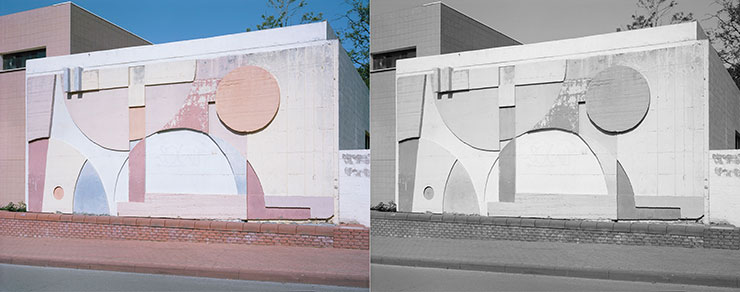
At the heart of the exhibition is a photograph of a concrete mural relief situated at the entrance to the Beit Yad Labanim memorial building (which from 1975 to 2000 also served as the Herzliya Museum’s main entrance). In this relief – created by the local artist Shlomo Eliraz – we see a combination of a formal, geometrically abstract arrangement, biblical verses, and excerpts from Natan Alterman’s poem, “The Silver Platter” – in keeping with conventional official and ceremonial protocol. Recently, the Mundi_Lab research group of the Technion’s Faculty of Architecture in Haifa (headed by Dr. David Behar-Perahia) removed the partitions between the memorial building and the museum, as part of ongoing research that they presented at the museum. Evron has placed a photograph of that relief within the museum space, as an integral part of it, in a bid to tackle the charged historical, national, and local contexts that it embodies. In addition, Evron invited the American artist Leslie Baum – a graduate of the IIT Institute of Design in Chicago, founded as the New Bauhaus – to respond to it in her own language, which engages with the modernist heritage. The juxtaposition between the photograph of the relief and these paintings offers a study of complementary contrasts, bringing together the universal and personal as well as an ideological call for the right to autonomy.
In recent years, the urban environment surrounding the museum has undergone profound changes, comprising spatial reorganization of the institutions in the city. This includes the municipality’s move to a building opposite the museum on Ben-Gurion Boulevard, near the law courts, and the opening up of the museum’s sculpture park to the street level. The particular case of Herzliya enables Evron to document and retrace, with a critical yet loving eye, processes of urban transformation, and to propose a means of deciphering the Zeitgeist that produced them. As a gesture of conservation and farewell, Evron reconstructs, within the museum’s exhibition space, a set of decorative red columns from the old Herzliya central bus station (designed by the architect Nahum Shani in the 1960s), which is to be replaced by a residential and recreational complex. In addition, Evron reconstructs the geometric decorative tiles that appear on the façade of a nearby building, that bear a direct reference to the formal language of Josef Albers, one of the most influential teachers at the Bauhaus. An additional decorative object (in the form of Oriental palms, originally made out of off-the-shelf ceramic tiles), is take from the façade of another neighboring building. In these elements we gain a glimpse of a brief moment of promise in the type of Israeli architecture designed and built by contractors without an architect, when decorativeness was combined with a promise of advanced functionality and suburban convenience, while preserving a measure of modesty and unpretentious directness; a moment that has since given away to an aesthetic of “residential projects” and “prestigious towers.”
Less Reading...
